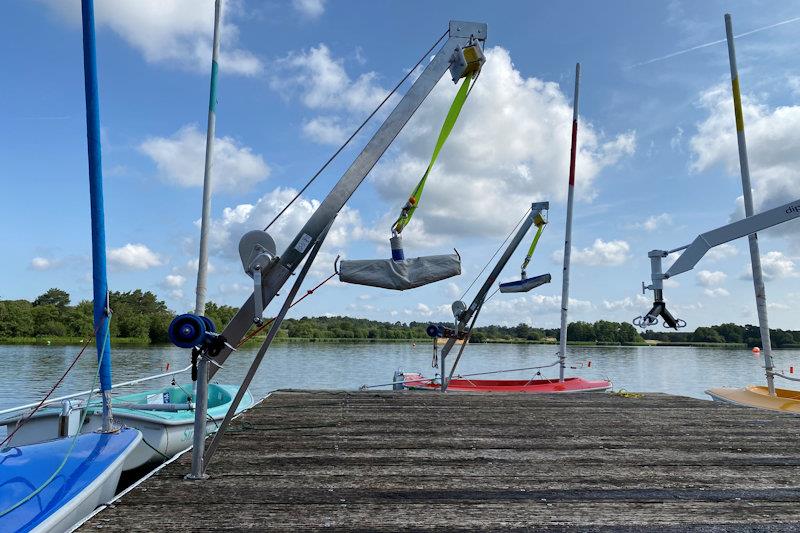
How do sailors with a disability get into a dinghy?
by Magnus Smith 20 Oct 2023 04:00 PDT

Frensham Pond Sailability has a variety of different hoist types on their jetty © Magnus Smith
Wheelchair users, and those whose strength/agility is impaired, need additional equipment to get into a sailing dinghy. Some clubs have been able to invest in slings and hoists to help sailors, and these photos were taken at the excellent Frensham Pond Sailability in the UK. This article should serve to inform sailors of the general options that will hopefully be available not too far from where they live.
The great news is that controlling a sailing boat is possible for almost anyone, even with a long term illness or disability, so the joy of freedom that comes with pleasure cruising, or competitive racing, is possible with some adaptations to the craft and the launch facilities.
Equipment: Hoists
The jetties at this club have several hoists fitted, so that multiple sailors can get on board at the same time, with less waiting in line. (Technically a crane-like contraption on a boat would be called a 'davit', but let's stick with words people recognise from home/hospital!)
There are two types of hoist; some have winches, and some use pump-action hydraulics. Each type allows a suspended sailor to be pivoted around, to dangle over the jetty or over a boat right next to the jetty. A person can be lowered gently into their seat in the boat.
In these photographs the boats are Hansa class, but the same hoists work on other craft, such as a 2.4m, RS Venture, or almost any other dinghy.
Equipment: Slings
The hoist connects to a sling: essentially a piece of fabric with straps, that you can sit on. Various types are available, and the more material there is, the more cocooned the sailor is whilst being lifted. This can be beneficial for someone who cannot support their head/limbs as well as others, and needs to stay wrapped tightly all around. Other sailors with more strength/control may be able to use a smaller sling, and this is preferable because it is easier to slide the smaller amount of fabric under the body whilst sitting in a wheelchair.
Clubs will have a variety of slings available, but some sailors purchase their own sling in order to lay it on their unoccupied wheelchair first thing in the morning, at home. This saves the difficulty of wriggling it under themselves once they arrive at the club.
Volunteers
It takes two people to operate a hoist, to get a sailor in or out of a dinghy. The photographs here show additional people, such as the carer accompanying the sailor, the co-skipper already in the boat, and sometimes a third volunteer lending a hand momentarily.
Volunteers should be provided with knee pads, as much of their time is spent kneeling on the jetty in order to help get the sailor comfortable and safe in the boat.
A good club will teach volunteers how to weave the straps of the sling so that the sailor doesn't slide out, and doesn't have their legs splay wildly apart, when hanging from a hoist.
The transfer process
When getting aboard a boat some moments can be less elegant than others. The gentleman shown here gave permission for his embarkation to be photographed! He had been an active yacht cruiser before long term illness had halted his enjoyment, and was glad to be in full control of a dinghy (with a volunteer in the boat with him, for safety).
Before even reaching the jetty, the sailor will have had to get into the sling, which entails sliding it under their body until they are sitting in it. In the photo below you can see the black fabric of the sling folded back on the top of the wheelchair.
Getting the feet to drop into a comfortable position is as important as where the sailor's posterior is being lowered into!
The photo above also illustrates the convenient placement of the Hansa's steering lever (joystick) for either sailor to hold. That same photo also leads us on to talk about how seating options can cause problems with buoyancy aids (look at the sailor's chin).
Personal flotation
Buoyancy aids for dinghy sailors are not designed to cope with the wearer slouching in a seat. Many sailors with disabilities cannot hold themselves upright easily, and as a result have to recline fully into the boat's seat. This can cause their buoyancy aid to ride up, and if their knees are raised too, this can cause the buoyancy aid to rise above their chin.
Give consideration to getting a sailor 'tucked in', or pick a different personal flotation device that doesn't obstruct the neck/face as much.
Bracing the feet is important for comfort and safety, and photos of options were covered in the previous article: Seating options for sailors with a disability
Further information
For getting from a dock/pontoon, to a boat that is floating alongside, many organisations use a 'transfer box' for sailors with sufficient arm strength.
A detailed document from US Sailing is very helpful: Adaptive Sailing Resource Manual [PDF], in particular page 38 Transfers and Assisted Lifts.
Get in touch
To notify the author of errors/omissions, or make requests for future articles, please email
With grateful thanks to the volunteers and sailors at Frensham Pond Sailability for allowing YachtsandYachting.com and Sail-World.com to photograph everything.